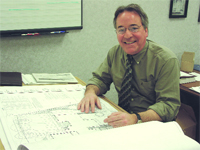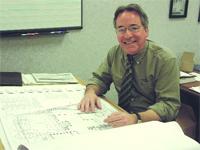
Hammering It Home
Western Builders Expands on Its Solid Foundation

Paul Ugolini says the economic downturn has created a highly competitive state that is just one of the many challenges facing builders today.
When discussing the changing nature of the construction sector in western Mass, Paul Ugolini looked to the past to contemplate the future.
President of Western Builders in Granby, Ugolini said that his shop, like many others, once employed a front-to-back approach to construction.
A long time ago, general contractors used to do all their own work in the construction industry. Now a lot of them dont, he said. But typically, a GC would do their own foundation, their own carpentry, the masonry, plastering. Now, because of the way the economy is, and with competition so strong, they sub it all out. Someone who does it all the time, they can do it far more efficiently than you can.
Maybe a handful of shops still operate like that, he continued, meaning the way it was years ago, but thats one instance where the industry has reinvented itself, and thats only been within the last 15 years. Who knows what will happen in the next 10 years?
Construction in the Pioneer Valley is currently at its most competitive state in decades. Ugolinis response to the changing face of the industry is to make sure that his team not only gets the job done right, but lets that job get more jobs.
Talking with BusinessWest recently, Ugolini considered the past, the present, and the future of both Western Builders and his industry.
Third Times a Charm
Ugolini is a good example of the hard work that will pay off in climbing the corporate ladder.
After graduating in the mid-80s with a bachelors degree in Civil Engineering from UMass Amherst, he said that hes worked in the construction field ever since.
I used to work for Macomber Builders out of Boston for a few years, and at one time they were talking about opening up a satellite office out here, he said. They ran out of work, and my option was to go back to working in Boston, but Western Builders had a job opening here, and I was thrilled to be able to return permanently to the area.
After starting out as a project manager in 2000, he steadily climbed the ranks to become the third president of the 34-year-old firm.
While owned by the parent organization the OConnell Companies, which also owns the larger construction firm Daniel OConnells Sons, Western Builders doesnt feel any competition from that local heavyweight.
Ugolini calls his firm small to mid-size, with a current staff of 15, which traditionally keeps its project roster in the under-$10 million range, putting the company in a different ballpark than its big brother in the field.
Most of the work we do is in the local area, said Ugolini, and he offered a roster of clients and projects including Bay Path College, Smith College, Glenmeadow Retirement Community in Longmeadow and the Lathrop Retirement Community in Easthampton. Additionally, Western Builders teamed up with world-famous architect Graham Gund to build the contemporary retail and residential complex in the center of South Hadley called the Village Commons.
We do a mix of work from colleges to supermarkets, assisted living, multi-residential, Ugolini said. We do all kinds of things. The only thing we dont do is heavy and highway work, roadwork, bridgework, that kind of thing. Which we probably should because thats where the money is going to come in the future.
We have a great reputation, he continued. We have some real talent in the field, with some superintendents that have been with us for a long time.
And the word from the other side of the boardroom table is similar in nature.
Holyoke City Planner Kathleen Anderson said that Western Builders work on the Jones Ferry Boathouse has been very well-received, and that comments coming into City Hall are favorable for this example of green architecture on the Connecticut River.
This is a very important project to the city, she said, given that it is the only public access Holyoke has to the river. There are some complex systems at the building, like the green roof (planted with vegetation to absorb rainwater) and the solar systems, but everything is working out perfectly. We look forward to the building put into use later this spring.
Further south in the Paper City is another example of Westerns work, one that is likely to lead to additional work for the client.
After an $8.9 million Housing and Urban Development-assisted project for the Sisters of Saint Joseph in Holyoke, Western Builders put its reputation to task. Completed in 2008 at the congregations Mont Marie campus, the facility was designed to meet the needs of affordable housing for area senior citizens.
Sr. Denise Granger is on the Leadership Team for the SSJ, and also is the president of the Mont Marie Senior Residence Inc.
This was our first venture into a large project, said Granger. The work involved a gut, rehab of one of our buildings, and had to be tailored to be accomplished within the amount of money we had. We had a lot to learn and had a lot of guidance, but some of our best advice and ideas came from Western Builders site supervision, Mike Guy, and the project supervisor, Mike Flanders. As the 14-month project unfolded, we developed a mutual understanding and built a trust level that resulted in a wonderful building.
The results paid off. Granger mentioned that, due to such a positive relationship with the builders, she plans to contract with them again for another large project on the books for the SSJ.
Bidding Wars
Ugolini noted that Western Builders has a few projects on the books for the coming year and that, while times are tight, he isnt too worried about how the economic climate is going to affect his shop. We do have a fairly decent backlog; its just about waiting for those things to start, he said.
But the economy is hitting the sector at large pretty hard, and the nature of project bids has gotten to a level Ugolini has never seen in his time in the field.
Were bidding things on and off, he continued. Well bid things where we think that well actually have a shot at getting the project.
But after a recent open call for bids at Holyokes Multimodal Transportation Center at the old fire station on Maple Street, Ugolini shook his head as he described the scene. Youd think it was a pancake breakfast, there were so many builders there. The architect had two people walking around with sign-in sheets because of the volume. Ive never seen anything like that. Its unbelievable. What do you think you need to do to get a job like that? You have to go in there with either nothing as your margin, or below nothing.
He mentioned that Western Builders would consider looking outside the region for work, but not often, and laughed when talking about peoples commitment to keeping local workforce on a project. You always hear that when the client goes before the Planning Committee!
After completing the Red Robin restaurant chains Holyoke outlet, Ugolini considered his firm in good stead for the pending Wilbraham branch. We lost that bid to a Maine contractor. Everybody he hired was from Maine; not a single person was local. I dont know how he can afford to do that. Maybe labor rates are much different in Maine, and they could be more aggressive, he laughed.
Western Influence
Ugolini said he gets the feeling that many of the shovel-ready stimulus projects are going to be outside the purview of his firm. Most of them, from what Ive seen, are roads, he said. And if not, they are either really huge, or very minor.
For us, he continued, we are going to go after more of those multi-housing projects, to capitalize on a winning formula for Western Builders.
Green architecture might prove to be the big buzz of the Obama years, and after finishing the Boat House in Holyoke, Western Builders will be no stranger to that trend. But Ugolini doesnt know how much he sees those techniques trickling down to the everyday project.
These systems are costly, and really, how many people in this area can afford to put up green buildings? he asked. My definition of green architecture goes beyond paint, or products, and smaller details. I think of all the building systems wastewater, solar. The larger colleges can afford this, but an investor putting up a couple-million-dollar office building somewhere, would they spend that kind of money? I dont know.
While the job market for the building industry looks into the future of 2009 with hope for a return to a stable economy, Ugolini said that Western Builders is well-placed to continue in the same direction. The best thing for us to do is to keep going in the direction weve been going, and to wait for the projects weve got on the books to get their funding.
But, he conceded, maybe some reinvention could be considered. Its an increasingly changing market out there, and weve got to come up with competitive ways to get the job done.
Since the start, thats been the business model at Western Builders.






